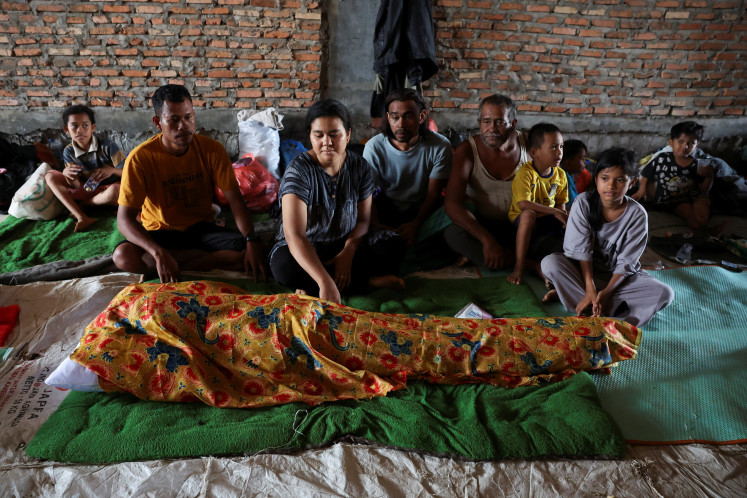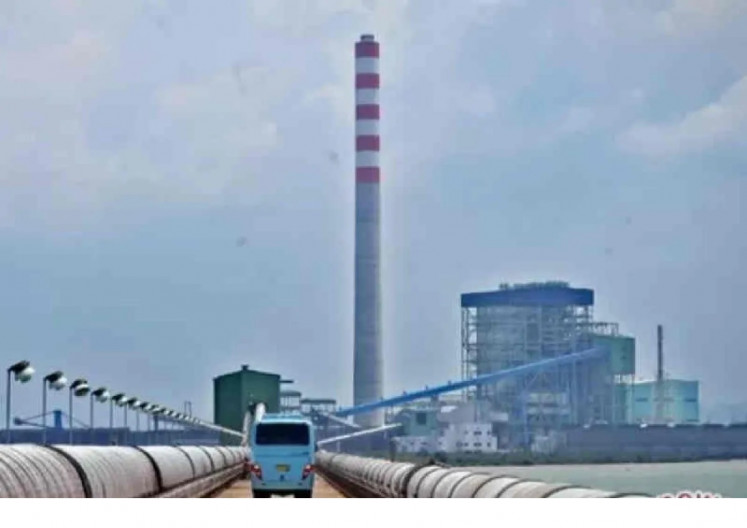Popular Reads
Top Results
Can't find what you're looking for?
View all search resultsPopular Reads
Top Results
Can't find what you're looking for?
View all search resultsThe lost lands of Takalar
Under threat: A child walks on a beach of Laikang Bay, Mangara Bombang district, Takalar regency, South Sulawesi
Change text size
Gift Premium Articles
to Anyone
U
span class="caption" style="width: 378px;">Under threat: A child walks on a beach of Laikang Bay, Mangara Bombang district, Takalar regency, South Sulawesi. Coastal erosion has become an alarming issue in the region. JP/Andi Hajramurni
The coastline of Takalar regency, South Sulawesi, has been eroding at the increasingly alarming rate of 20 meters over the last five years and up to 100 meters a year in certain areas.
In fact, the regency’s 19-kilometer coastline is almost entirely damaged although the destruction comes in varying degrees from severe, moderate to slight.
The six affected districts affected are Galesong, North Galesong, South Galesong, Sanrobone, Mangara Bombang and Mappakasunggu.
The environment and investment office of Takalar regency recorded seven kilometers of its coast as seriously eroded, five kilometers as moderately damaged, and the remainder as slightly affected with a small part unaffected.
“Erosion in Takalar is getting worse,” said Alwy Rahman, the head of the environment and investment office of Takalar recently.
Apart from the coastal zone, settlements, roads and bridges as well as cemeteries have also been adversely affected.
The varying degrees of erosion have forced 400 families to relocate.
According to Alwy, unless promptly dealt with, the erosion is likely to have a worse impact.
“We need to build concrete embankments and breakwaters quickly. But sadly, we don’t have enough funds to do this,” he said.
Soil in Takalar is said to be eroding mainly because of human activity removing the area’s natural protection against waves.
People are removing mangroves on a large scale, fishing using explosives therefore destroying coral reefs which normally function as barriers to waves.
The worst erosion tends to occur from January to March, when waves reach three to five meters high.
No more losses: dozens of residents stage a protest rejecting a reclamation project in Lette subdistrict, Makassar, unless they receive compensation for their lost land. JP/Andi Hajramurni
The Jakarta Post recently observed that some parts of land in Takalar had been eroded by seawater, reaching hundreds of meters ashore.
In North Galesong district, particularly in Bontosunggu, Lambutua and Palalakang villages, waves have been battering the land, damaging dozens of village homes and displacing their occupants.
With coastal land shrinking, houses are likely to disappear, like that of Jumat Daeng Sarro, 40, in Palalakang. Half of his concrete building collapsed after high waves hit it in 2008. When it was built some years ago, the house was still dozens of meters away from the shore.
“From year to year, erosion continues, reducing the distance from the house to shore. In the wet season of 2008, waves three to five meters high caused severe damage, smashing part of my 7-meter-long house,” said Jumat.
“A number of residents and I have planned to move because another bout of erosion is definitely going to reduce our homes to rubble. Some of us already moved last year,” added Jumat, who works as a fisherman.
In Bontosunggu, a cemetery has lost over ten meters of land, causing dozens of graves disappear. In fact, the graveyard was originally dozens of meters from the shoreline and over three meters above sea level.
Daeng Amang, 65, a guard at the Tamasonga cemetery, said the erosion had been an ongoing issue but had worsened in the last four years.
“Every time high waves hit our shores, we end up finding human bones scattered around,” he said, collecting several skull bone pieces from the sandy graves.
He added that 30 years ago, coconut trees and other wood-producing trees used to line the shore of Bontosunggu, but those had been swept away one by one by relentless waves. But he claimed no mangroves had ever grown in the area.
The only protection the village has is a number of buildings used to breed shrimps, located behind by a Taiwanese company on the shore. However some of the idle buildings there have also been damaged and crumbled to pieces.
Bontosunggu village secretary Ibrahim said the erosion in his area, of 10 to 15 meters a year, would keep getting worse unless the government built concrete embankments without delay to block waves.
In his view, only such dikes can stop the village from disappearing because this area is not fit for mangroves. “We once tried to grow mangroves but the waves washed them away. The only suitable barriers are concrete embankments,” he added.
Worse erosion can be seen in Sanrobone village, Sanrobone district. Within 25 years, three kilometers of land has been lost. A mosque built in 1985 about three kilometers from the shore is now only several meters away. Dozens of houses in the area have also become inhabitable.
The same holds true for Mangara Bombang district, especially in the tourist areas of Topejawa, Lamakiang and in Laikang village. Along the way leading to this village’s last hamlet, Puntondo, the shoreline has come very close to village paths and settlements.
Mangroves and other coastal plants are rarely seen along the village shore while broken pieces of coral reefs are scattered all over the beach. The government has indeed built concrete dikes but only short ones, besides growing mangroves. Locals have also piled sand sacks on the shore.
Muhammad Suaeb from the environment resources division, Takalar’s environment and investment office, said planting mangroves to overcome erosion in Takalar should be combined with building embankments and breakwaters.
“Based on our surveys, not all the soil structures in Takalar are suitable for mangrove planting.
Therefore, some zones require concrete dikes while others need breakwaters,” explained Suaeb.
He specified that out of the 12 kilometers of eroded coastal area, 2.7 kilometers needed embankments, while mangroves should be grown along two kilometers and breakwaters were needed along 7.3 kilometers.
“The government has built 2.7-kilometer dikes but they now need to be renovated as they have also been damaged. We’ve also planted mangroves but they have only been effective along 700 meters. Our efforts [to stop erosion] are not fast enough though. But there isn’t much we can do with limited funds,” added Suaeb.
The Environment Education Center of Puntondo, an NGO, is one of the agencies actively raising awareness in Puntondo hamlet about restoring the coasts in this area. It is also encouraging locals to grow mangroves, stop fishing illegally and use bamboo baskets or containers to breed fish.











